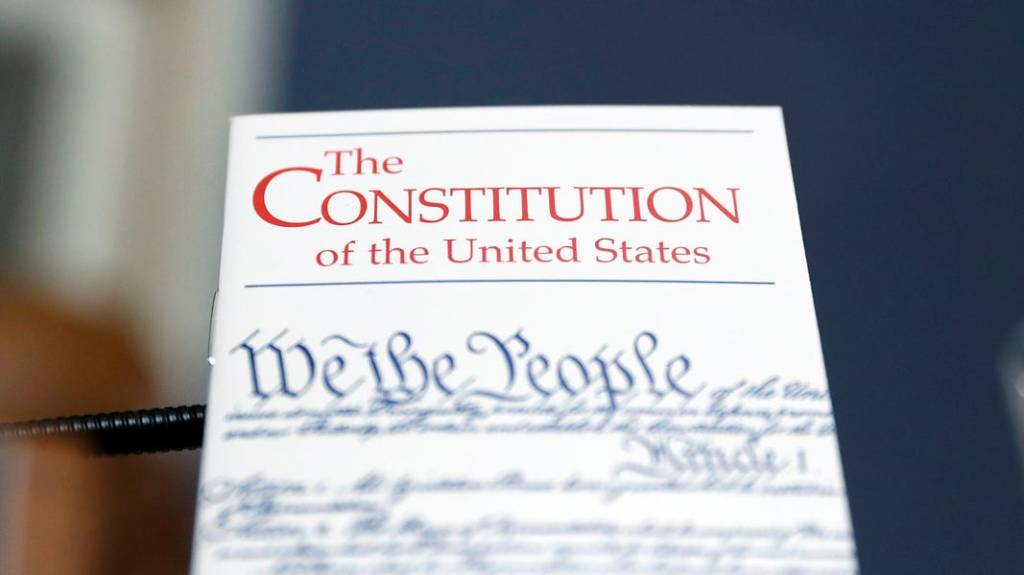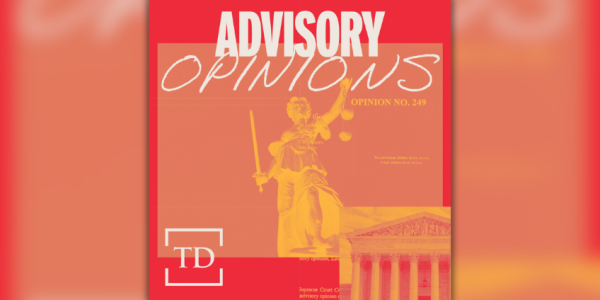Let’s take a break from the relentless and exhausting news cycle for a moment and discuss one of my favorite topics: LeBron James and the airtight case for his GOATness.
No, not really. Not today anyway. We’ll wait until after the Lakers claim the NBA championship later this fall. Instead, let’s discuss something even more interesting than professional basketball—federalism.
As a longtime small-government conservative in good standing, I’m going to sheepishly confess a bit of a troubled personal relationship with federalism. I’ve grown to feel about federalism the same way that Homer Simpson feels about alcohol. It’s both problem and solution:
What’s the problem with federalism? It’s so polarizing that it once fractured our nation. What is it the solution for? The toxic polarization that could fracture our nation.
I’m raising federalism as a topic in part because I just finished participating in a fascinating bipartisan discussion on the promise and perils in this national moment. The world, in some ways, is turning upside down. Some conservatives are turning nationalist. Some progressives are discovering a new love for localism.
As I said, I’ve been torn. On the one hand, I’ve always had a great deal of theoretical and intellectual affection for federalism. Yes, let’s push government to the level closest to the people. Yes, let’s protect the right of states and cities to fashion policies that build communities that reflect the values and priorities of their citizens. One size does not fit all.
Or, to put things more plainly—let California be California and let Tennessee be Tennessee.
But then there’s the difference between theory and practice. I grew up in the small-town South (mainly in Kentucky), and one of our salient, sad realities is that government often got worse the closer it got to the people. Fewer people voted in local elections than national elections, local officials were often corrupt, and it sometimes felt as if there was no adult supervision until one could conceivably escalate their grievance all the way up to the federal level.
Welcome to the days of “Operation BOPTROT” where the going price for influencing legislation in the Commonwealth of Kentucky was as low as $400.
And so, when the Republican Revolution of the 1990s got truly underway, the conservative in me cheered for more local control. The Kentuckian in me had a bit of a different response:

Interestingly, however, as the coronavirus pandemic took off, quite a few Americans had exactly the opposite reaction. As a matter of theory, they cheered the idea of a massive, competent national response to a national crisis. As a matter of fact, however, they often watched state authorities respond to the crisis far more effectively and competently than the national government, and the contrast between presidential and gubernatorial approval ratings partly reflect that gap.
It turns out that there’s simply a desperate need for good government, and people will take it where they can find it—whether it’s local, state, or federal. And that’s exactly where arguments over federalism so often bog down. They’re excessively influenced by the quality of each layer of government at any given moment.
But let’s set aside the fleeting and shifting considerations of good government for the moment and instead focus on the imperative of an effective system—the system that can sustain national unity in the face of increasing polarization, the geographic “Big Sort,” and increasing cultural fragmentation. And in that context, I strongly believe it’s necessary to reverse the seemingly inexorable trend towards increasing nationalization in favor of revived federalism, properly understood.
So, yep, we’re back to letting California be California and Tennessee be Tennessee.
I see the evolution of federalism in the United States as broadly proceeding in three phases, and it’s time for a fourth.
The first phase was “necessary federalism.” There was simply no way to meld together the 13 colonies without granting them a high degree of sovereignty and autonomy. Even though the Constitution contained grand promises and granted the federal government significant potential power, in many ways it had limited reach and effect. For example, many Americans are surprised to learn that the original Bill of Rights had almost no application to any American’s life. It restrained only the federal government, and the federal government was (by today’s standards) extraordinarily small and weak.
(Of course the constitutional government was stronger than the national government under the Article of Confederation, but papier-mâché was stronger than the first American government.)
But necessary federalism quickly led to the next phase—“broken federalism.” The Southern states in particular used their autonomy to continue slavery, to suppress dissent, and to cultivate a form of state and regional pride that culminated not just in secession but in a very real cultural and political belief (held by Robert E. Lee and many, many other Confederates) that they were citizens of their states first, then citizens of the nation.
Sadly, except for the first few years of Reconstruction, broken federalism extended for almost a century after the Civil War. It turns out that any federalist structure that withholds from any American citizen the “privileges or immunities” of citizenship cannot be sustained. It creates an unbearable tension with the principles of the American founding.
The solution to broken federalism was “necessary nationalism.” At its heart, it involved not just a consolidation of federal power to withstand the triple challenge of the Great Depression, World War II, and the Cold War, it also involved a consolidation of federal power to extend the blessings of liberty to every American citizen.
It’s a process that first began—most obviously—with emancipation. It continued with the Civil War amendments, sustained itself through the long judicial process of applying the Bill of Rights to the states, and then culminated in the Civil Rights Act of 1964, the law that finally swept away the legal “badges and incidents of slavery” that had so dominated life for tens of millions of black Americans.
But now, I submit, the further consolidation of national power is a poor fit for the times.
So what’s the prudent fourth phase? It’s time for “healthy federalism.” A highly-polarized nation is ill-suited for continued consolidation of power in the federal government, much less in the executive branch of the federal government.
We’re increasingly racially diverse. We’re increasingly religiously diverse. We’re increasingly ideologically opposed. In what world, then, does it make sense to magnify the power of one man to rule over us all?
At the same time, we cannot return either to the flawed necessary federalism of the founding or the broken federalism it spawned. Healthy federalism should retain the fundamental promise of the Bill of Rights, the Civil War amendments, and the Civil Rights Act—three key pillars of the modern American social compact—while expanding state autonomy and state power to regulate and legislate economic, environmental, educational, and fiscal policy.
If I had to sum up one of the worst fears of my Democratic friends in two words, it would be, “minoritarian control.” With two of the last three GOP presidential victories coming in spite of popular vote losses—and with a Senate structure that privileges small states—there is real concern that America could enter a period where the will of the majority is consistently thwarted by the resistance of the minority.
Conversely, two words that sum up Republican fears are “majoritarian tyranny.” There is real concern that America’s mighty progressive coastal power centers will sweep aside the rural and exurban heartland, diminishing religious freedom, limiting free speech, and stripping away inherent rights of armed self-defense.
Healthy federalism protects against both sides’ worst fears. Greater financial autonomy would grant progressive state governments much greater ability to build the health, welfare, and education systems they prefer. Continued robust protection for the Bill of Rights blocks the majoritarian bulldozer.
But here’s the catch — and considering the mutual hatred that all too often dominates America’s political and activist class, it’s a big catch indeed. Just as civil libertarians are used to defending the free speech or due process rights of even their most fierce political opponents, the new federalism will end up allowing the “bad guys” to win.
Remember how Wisconsin’s union reforms turned into a national political controversy?
Remember how California’s sanctuary state laws triggered Trump administration lawsuits?
We’re in the grips of a political culture that consistently nationalizes local disputes, and thus Tennessee Sen. Marsha Blackburn exercises far too much control over the lives of the people of California, and Nancy Pelosi has far too much influence over the people of Tennessee. In a strange way, it turns out that members of America’s political classes loathe each other too much to simply leave their opponents alone.
One of my most popular recent newsletters called for the rise of “Bill of Rights Republicans” and endorsed a series of law enforcement reforms as part of an effort to double-down on the American social compact. But in imagining conservatism after Trump, the Bill of Rights (as much as I love it) gets you only so far. In domestic policy, the next conservatism should look to at our increasingly diverse nation and instead of believing that greater centralization can somehow knit our nation together, it should instead look at pluralistic American society and declare to America’s states and cities, “We’ll help you build the future you want.”
One last thing …
I’m still a little shook at how many members don’t like Will Ferrell. But do y’all know he’s a comedic and musical genius? Here’s a short song from his most recent movie, proving once again that for art to be immortal, it need not be eternal:
Photograph by Andrew Harnik/Getty Images.








Please note that we at The Dispatch hold ourselves, our work, and our commenters to a higher standard than other places on the internet. We welcome comments that foster genuine debate or discussion—including comments critical of us or our work—but responses that include ad hominem attacks on fellow Dispatch members or are intended to stoke fear and anger may be moderated.
You are currently using a limited time guest pass and do not have access to commenting. Consider subscribing to join the conversation.
With your membership, you only have the ability to comment on The Morning Dispatch articles. Consider upgrading to join the conversation everywhere.